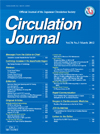Volume 66, Issue 1
Displaying 1-21 of 21 articles from this issue
- |<
- <
- 1
- >
- >|
Review Article
-
Article type: scientific monograph
Subject area: None
2002Volume 66Issue 1 Pages 1-9
Published: 2002
Released on J-STAGE: January 31, 2002
Download PDF (93K)
Special Article
-
Article type: scientific monograph
Subject area: None
2002Volume 66Issue 1 Pages 10-19
Published: 2002
Released on J-STAGE: January 31, 2002
Download PDF (456K) -
Article type: scientific monograph
Subject area: None
2002Volume 66Issue 1 Pages 20-29
Published: 2002
Released on J-STAGE: January 31, 2002
Download PDF (396K)
Clinical Investigation
-
Article type: scientific monograph
Subject area: None
2002Volume 66Issue 1 Pages 30-34
Published: 2002
Released on J-STAGE: January 31, 2002
Download PDF (204K) -
Article type: scientific monograph
Subject area: None
2002Volume 66Issue 1 Pages 35-40
Published: 2002
Released on J-STAGE: January 31, 2002
Download PDF (429K) -
Article type: scientific monograph
Subject area: None
2002Volume 66Issue 1 Pages 41-46
Published: 2002
Released on J-STAGE: January 31, 2002
Download PDF (546K) -
Article type: scientific monograph
Subject area: None
2002Volume 66Issue 1 Pages 47-52
Published: 2002
Released on J-STAGE: January 31, 2002
Download PDF (221K) -
Article type: scientific monograph
Subject area: None
2002Volume 66Issue 1 Pages 53-57
Published: 2002
Released on J-STAGE: January 31, 2002
Download PDF (180K) -
Article type: scientific monograph
Subject area: None
2002Volume 66Issue 1 Pages 58-62
Published: 2002
Released on J-STAGE: January 31, 2002
Download PDF (99K) -
Article type: scientific monograph
Subject area: None
2002Volume 66Issue 1 Pages 63-69
Published: 2002
Released on J-STAGE: January 31, 2002
Download PDF (206K) -
Article type: scientific monograph
Subject area: None
2002Volume 66Issue 1 Pages 70-74
Published: 2002
Released on J-STAGE: January 31, 2002
Download PDF (488K) -
Article type: scientific monograph
Subject area: None
2002Volume 66Issue 1 Pages 75-79
Published: 2002
Released on J-STAGE: January 31, 2002
Download PDF (353K)
Experimental Investigation
-
Article type: scientific monograph
Subject area: None
2002Volume 66Issue 1 Pages 80-86
Published: 2002
Released on J-STAGE: January 31, 2002
Download PDF (561K) -
Article type: scientific monograph
Subject area: None
2002Volume 66Issue 1 Pages 87-92
Published: 2002
Released on J-STAGE: January 31, 2002
Download PDF (241K) -
Article type: scientific monograph
Subject area: None
2002Volume 66Issue 1 Pages 93-96
Published: 2002
Released on J-STAGE: January 31, 2002
Download PDF (60K) -
Article type: scientific monograph
Subject area: None
2002Volume 66Issue 1 Pages 97-103
Published: 2002
Released on J-STAGE: January 31, 2002
Download PDF (550K)
Case Report
-
Article type: scientific monograph
Subject area: None
2002Volume 66Issue 1 Pages 104-106
Published: 2002
Released on J-STAGE: January 31, 2002
Download PDF (782K) -
Article type: scientific monograph
Subject area: None
2002Volume 66Issue 1 Pages 107-108
Published: 2002
Released on J-STAGE: January 31, 2002
Download PDF (83K) -
Article type: scientific monograph
Subject area: None
2002Volume 66Issue 1 Pages 109-110
Published: 2002
Released on J-STAGE: January 31, 2002
Download PDF (94K) -
Article type: scientific monograph
Subject area: None
2002Volume 66Issue 1 Pages 111-113
Published: 2002
Released on J-STAGE: January 31, 2002
Download PDF (430K)
Rapid Communication
-
Article type: scientific monograph
Subject area: None
2002Volume 66Issue 1 Pages 114-116
Published: 2002
Released on J-STAGE: January 31, 2002
Download PDF (124K)
- |<
- <
- 1
- >
- >|
